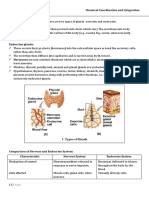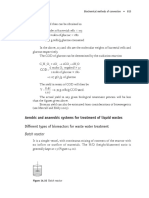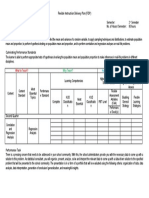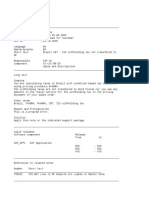Adrenocorticotropic Hormone (ACTH) From The Anterior Pituitary Gland Specifically Stimulates
Adrenocorticotropic Hormone (ACTH) From The Anterior Pituitary Gland Specifically Stimulates
Uploaded by
Stjepan ErženCopyright:
Available Formats
Adrenocorticotropic Hormone (ACTH) From The Anterior Pituitary Gland Specifically Stimulates
Adrenocorticotropic Hormone (ACTH) From The Anterior Pituitary Gland Specifically Stimulates
Uploaded by
Stjepan ErženOriginal Description:
Original Title
Copyright
Available Formats
Share this document
Did you find this document useful?
Is this content inappropriate?
Copyright:
Available Formats
Adrenocorticotropic Hormone (ACTH) From The Anterior Pituitary Gland Specifically Stimulates
Adrenocorticotropic Hormone (ACTH) From The Anterior Pituitary Gland Specifically Stimulates
Uploaded by
Stjepan ErženCopyright:
Available Formats
INTRODUCTION
Hormones are chemical substances that affect the activity of another part of the body.
Hormones serve as messengers, controlling and coordinating activities throughout the
body.They are carried by the circulatory system to cells throughout the body, where they bind
with receptors and initiate many cell reactions. Some endocrine hormones affect many different
types of cells of the body; for example, growth hormone (from the anterior pituitary gland)
causes growth in most parts of the body. Other hormones affect mainly specific target tissues
because these tissues have abundant receptors for the hormone. For example,
adrenocorticotropic hormone (ACTH) from the anterior pituitary gland specifically stimulates
the adrenal cortex, causing it to secrete adrenocorticalhormones.
ENDOCRINE SYSTEM
Hormones are secreted by endocrine glands. Endocrine glands are ductless glands of
the endocrine system that secrete their products, hormones, directly into the blood. The major
glands of the endocrine system include the pineal gland, pituitary
gland, pancreas, ovaries, testes, thyroid gland, parathyroid gland, hypothalamus and adrenal
glands. In this picture we can see all of these glands and their hormones.
CHEMICAL STRUCUTRE OF HORMONES
Hormones can be devided in three general classes:
1. Proteins and polypeptides, including hormones secreted by the pituitary gland, the
pancreas (insulin and glucagon), the parathyroid gland (parathyroid hormone), and
many others. Polypeptide and protein hormones are stored in secretory vesicles until
needed. Most of the hormones in the body are polypeptides and proteins.
2. Steroids secreted by the adrenal cortex (cortisol and aldosterone), the testes
(testosterone), the ovaries (estrogen and progesterone), and the placenta (estrogen and
progesterone). Steroid hormones are usually synthesized from cholesterol and are not
stored. The chemical structure of steroid hormones is similar to that of cholesterol. They
are lipid soluble and consist of three cyclohexyl rings and one cyclopentyl ring
combined into a single structure.
3. Derivatives of the amino acid tyrosine, secreted by the thyroid (thyroxine and
triiodothyronine) and the adrenal medullae (epinephrine and norepinephrine). Hormone
secretion occurs when the amines are split from thyroglobulin, and the free hormones
are then released into the blood stream. After entering the blood, most of the thyroid
hormones combine with plasma proteins, which slowly releases the hormones to the
target tissues.
FEEDBACK CONTROL OF HORMONE SECRETION
Although the plasma concentrations of many hormones fluctuate in response to various
stimuli that occur throughout the day, all hormones studied so far appear to be closely
controlled. This control is exerted through negative feedback mechanisms that ensure a proper
level of hormone activity at the target tissue. After a stimulus causes release of the hormone,
products resulting from the action of the hormone tend suppress its further release. In other
words, the hormone has a negative feedback effect to prevent oversecretion of the hormone.
Therefore, only when the target tissue activity rises to an appropriate level will feedback signals
to the endocrine gland become powerful enough to slow further secretion of the hormone.
TRANSPORT OF HORMONES IN BLOOD
Water-soluble hormones (peptides and catecholamines) are dissolved in the plasma and
transported from their sites of synthesis to target tissues, where they diffuse out of the
capillaries, into the interstitial fluid, and ultimately to target cells.
Steroid and thyroid hormones, in contrast, circulate in the blood mainly bound to plasma
proteins. However, protein-bound hormones cannot easily diffuse across the capillaries and
gain access to their target cells and are therefore biologically inactive until they dissociate from
plasma proteins.
MECHANISMS OF ACTION OF HORMONES
First of all, hormon binds to specific receptors at the target cell. Cells that lack receptors
for the hormones do not respond. Receptors for some hormones are located on the target cell
membrane, whereas other hormone receptors are located in the cytoplasm or the nucleus. When
the hormone combines with its receptor, this usually initiates a cascade of reactions in the cell.
Each receptor is usually highly specific for a single hormone; this determines the type of
hormone that will act on a particular tissue. The target tissues that are affected by a hormone
are those that contain its specific receptors. The locations for the different types of hormone
receptors are the following:
1. In or on the surface of the cell membrane. The membrane receptors are specific for the
protein and peptide hormones because they can not pass threw the cell membrane.
2. In the cell cytoplasm. The primary receptors for the steroid hormones are found mainly
in the cytoplasm because they can dissolve in the membrane and enter in the cytoplasm.
3. In the cell nucleus. The receptors for the thyroid hormones are found in the nucleus.
You might also like
- Hookes LawDocument23 pagesHookes LawAman Singh100% (2)
- SLIDE2-Basic Rock PptiesDocument100 pagesSLIDE2-Basic Rock PptiesolaseyeNo ratings yet
- D151821 0020Document1 pageD151821 0020vuongspkt12007100% (8)
- Endocrine SystemDocument18 pagesEndocrine SystemanthophileaNo ratings yet
- Introduction To Endocrinology and Mechanism of Actions of HormobesDocument16 pagesIntroduction To Endocrinology and Mechanism of Actions of Hormobeseduviere46No ratings yet
- المحاضرةالثانية 3كيمياء حيويDocument21 pagesالمحاضرةالثانية 3كيمياء حيويkhodaira2010No ratings yet
- What Are HormonesDocument16 pagesWhat Are HormonesHarry RoyNo ratings yet
- UntitledDocument12 pagesUntitledDerrick kinyaNo ratings yet
- Hormone: For Other Uses, SeeDocument5 pagesHormone: For Other Uses, SeeEki Ryan SetiowatiNo ratings yet
- EndocrinologyDocument35 pagesEndocrinologyNasif HussainNo ratings yet
- Dmma College of Southern Philippines Anatomy and Physiology of Endocrine SystemDocument16 pagesDmma College of Southern Philippines Anatomy and Physiology of Endocrine SystemCandy Penpillo SaldiviaNo ratings yet
- Hormones, ClassificationDocument10 pagesHormones, ClassificationMenoNo ratings yet
- Endocrine Anatomy and PhysiologyDocument10 pagesEndocrine Anatomy and PhysiologyJojo JustoNo ratings yet
- ENDOCRINE SYSTEM - Anatomy and PhysiologyDocument10 pagesENDOCRINE SYSTEM - Anatomy and PhysiologyJay Crishnan Morales CajandingNo ratings yet
- Hormone: For Other Uses, SeeDocument4 pagesHormone: For Other Uses, SeePrasanna Nair ParameswaranNo ratings yet
- Endocrine SystemDocument95 pagesEndocrine SystemUmar Ilyasu JibrilNo ratings yet
- Endocrine Glands & Their Functions: Anatomy & Physiology II Georgia Perimeter College K. Donaldson, InstructorDocument55 pagesEndocrine Glands & Their Functions: Anatomy & Physiology II Georgia Perimeter College K. Donaldson, InstructorIsaacJ22No ratings yet
- Unit 1 Courselink NotesDocument27 pagesUnit 1 Courselink NotesLauren StamNo ratings yet
- The Endocrine System: An OverviewDocument12 pagesThe Endocrine System: An Overviewlovelyc95No ratings yet
- Introduction To Endocrinology: Dr. Jehad Al-ShuneigatDocument21 pagesIntroduction To Endocrinology: Dr. Jehad Al-Shuneigatyousef sarairehNo ratings yet
- Basic Principles of Endocrine PhysiologyDocument54 pagesBasic Principles of Endocrine Physiologyjuniorsalim126No ratings yet
- Biochemistry of HormonDocument16 pagesBiochemistry of HormonMuhamad SdeqNo ratings yet
- Biology ProjectDocument27 pagesBiology Projectravifact0% (2)
- Endocrine System-1Document90 pagesEndocrine System-1markmuiruri581No ratings yet
- Endocrine SystemDocument22 pagesEndocrine Systempranutan739No ratings yet
- Endrocrinology - PPTX Version 1Document40 pagesEndrocrinology - PPTX Version 1Abishek BhadraNo ratings yet
- Lecture 3Document4 pagesLecture 3Ubaid HassanNo ratings yet
- LMS Endocrine SystemDocument23 pagesLMS Endocrine Systemhakdog hakdogNo ratings yet
- Chemistry ProjectDocument23 pagesChemistry Projecttwinklelee123450% (2)
- 4 Endocrine 1Document18 pages4 Endocrine 1ShenNo ratings yet
- Anatomy and Physiology-Endocrine SystemDocument5 pagesAnatomy and Physiology-Endocrine SystemEixid Enna YeLik100% (1)
- The Endocrine System Part 1Document64 pagesThe Endocrine System Part 1rizwanbasNo ratings yet
- Module 5Document10 pagesModule 5Jayvee VillaramaNo ratings yet
- Coordination of Body Functions by Chemical MessengerDocument6 pagesCoordination of Body Functions by Chemical MessengerHorain FatimaNo ratings yet
- Clinton Hackney Anatomy & Physiology II BctcsDocument65 pagesClinton Hackney Anatomy & Physiology II BctcsJack HolthouseNo ratings yet
- ZLY 106 - The Endocrine SystemDocument12 pagesZLY 106 - The Endocrine Systemlordsonezema1No ratings yet
- Endocrine SystemDocument41 pagesEndocrine SystemMerrin EncarnacionNo ratings yet
- 5.endocrine System ++Document21 pages5.endocrine System ++fbn87rfm2jNo ratings yet
- Module 04Document14 pagesModule 04acrehell8No ratings yet
- HormonesDocument23 pagesHormonesKU ExergonicNo ratings yet
- Artikel Biopsikologi Kelompok 10Document10 pagesArtikel Biopsikologi Kelompok 10Haloo MaaNo ratings yet
- Hormones:: Signaling MoleculesDocument20 pagesHormones:: Signaling MoleculesSangeeta DwivediNo ratings yet
- Introduction - CC3: Mechanism of Hormonal ActionDocument40 pagesIntroduction - CC3: Mechanism of Hormonal ActionAl-hadad AndromacheNo ratings yet
- Commercial Production of HormonesDocument2 pagesCommercial Production of HormonessumayyaNo ratings yet
- Sheena Khan: Biochemistry Generiic Bs NursingDocument22 pagesSheena Khan: Biochemistry Generiic Bs NursingsharmeenNo ratings yet
- The Endocrine System - PMCDocument20 pagesThe Endocrine System - PMCStephanie TeddNo ratings yet
- Endocrine System OutlineDocument17 pagesEndocrine System OutlineEsthermae PanadenNo ratings yet
- Forelæsning 3Document8 pagesForelæsning 3natashathelinNo ratings yet
- Hormon Provided by Medico SlidesDocument31 pagesHormon Provided by Medico SlidesMuhammad NaveedNo ratings yet
- Function of Endocrine SystemDocument7 pagesFunction of Endocrine SystemCeelin RoblesNo ratings yet
- Activity 16 HormonesDocument16 pagesActivity 16 HormonesKendrix Aguiluz FlorendoNo ratings yet
- Human HormonesDocument54 pagesHuman HormonesKhawaja EshaNo ratings yet
- Physio Endo 1Document28 pagesPhysio Endo 1moh.tarig12dNo ratings yet
- Endocrine SystemsDocument36 pagesEndocrine Systemsofficiallanarhoades16No ratings yet
- Principles of Hormonal Control SystemDocument25 pagesPrinciples of Hormonal Control SystemFAHEEM UD DINNo ratings yet
- Basic Concempts of Endocrine RegulationDocument50 pagesBasic Concempts of Endocrine RegulationHomeground entertainmentNo ratings yet
- How Endocrine WorksDocument19 pagesHow Endocrine WorksSwad Abdul khalikNo ratings yet
- Chapter 3 - Endocrine System NHR2021Document49 pagesChapter 3 - Endocrine System NHR2021h6qvqwvk2xNo ratings yet
- Johanna Jane H. Macasero - Endocrine System TranscriptDocument13 pagesJohanna Jane H. Macasero - Endocrine System TranscriptJohanna MacaseroNo ratings yet
- Human Endocrine System - Grade 11 & 12Document29 pagesHuman Endocrine System - Grade 11 & 12Ishita SinghNo ratings yet
- Endocrine SystemDocument20 pagesEndocrine SystemK8Y KattNo ratings yet
- Endocrine System: A Tutorial Study GuideFrom EverandEndocrine System: A Tutorial Study GuideRating: 5 out of 5 stars5/5 (1)
- Anatomy and Physiology: The Endocrine System: Things You Should Know (Questions and Answers)From EverandAnatomy and Physiology: The Endocrine System: Things You Should Know (Questions and Answers)No ratings yet
- Week60 61 PDFDocument25 pagesWeek60 61 PDFVineeth SivarajNo ratings yet
- Splitting Large Volume BIP Report Output Into Multiple Output FilesDocument5 pagesSplitting Large Volume BIP Report Output Into Multiple Output Fileschandan_infotechNo ratings yet
- Ee102 Lab 2Document8 pagesEe102 Lab 2Khuresh ShahNo ratings yet
- Written Assignment Discrete Math Unit 7Document4 pagesWritten Assignment Discrete Math Unit 7ayotunde oniNo ratings yet
- Science Class X Sample Paper Test 04 For Board Exam 2024Document7 pagesScience Class X Sample Paper Test 04 For Board Exam 2024i2iacademyinfoNo ratings yet
- Tutorial 15Document5 pagesTutorial 15Pace AjjaNo ratings yet
- Flexible Instruction Delivery Plan (FIDP) Grade: Semester: Core Subject Title: No. of Hours/ Semester: Core Subject DescriptionDocument1 pageFlexible Instruction Delivery Plan (FIDP) Grade: Semester: Core Subject Title: No. of Hours/ Semester: Core Subject DescriptionJoy TamalaNo ratings yet
- Computer Vision Grading System For Physical Quality Evaluation of Green Coffee BeansDocument12 pagesComputer Vision Grading System For Physical Quality Evaluation of Green Coffee BeansVictor CcapaNo ratings yet
- C-Mos FDC (Floppy Disk Controller)Document3 pagesC-Mos FDC (Floppy Disk Controller)Bos QuNo ratings yet
- Explanation - Design of AD Fixed Dome Reactor For A Vegetable MarketDocument3 pagesExplanation - Design of AD Fixed Dome Reactor For A Vegetable MarketAlexis ChicaizaNo ratings yet
- Unit 2Document6 pagesUnit 2humbleavi100% (1)
- OTC-25676-MS Implementing Constructability in Brownfield Projects: A Case StudyDocument13 pagesOTC-25676-MS Implementing Constructability in Brownfield Projects: A Case StudyFrancisco DondaNo ratings yet
- Akka HTTPDocument23 pagesAkka HTTPTejaswiniNo ratings yet
- Basic Cement ChemistryDocument13 pagesBasic Cement Chemistrydina safiriNo ratings yet
- mfLabUserGuide1305 PDFDocument98 pagesmfLabUserGuide1305 PDFAlfredo Dex Quispe MarrónNo ratings yet
- Time Value 2Document20 pagesTime Value 2Rose BacalsoNo ratings yet
- Informacion Tecnica Valvula Motora Gas de AltaDocument8 pagesInformacion Tecnica Valvula Motora Gas de AltaGuille MVNo ratings yet
- Lab Report VibrationDocument5 pagesLab Report Vibrationinterdex_006No ratings yet
- Subject - Verb - AgreementDocument27 pagesSubject - Verb - Agreementthakursuryapratap6No ratings yet
- Coming HomeDocument337 pagesComing HomeSorin VintzeanuNo ratings yet
- 13th Shoot How Not To Solve Anagram Problem Using MRDocument26 pages13th Shoot How Not To Solve Anagram Problem Using MRpalanivelNo ratings yet
- Adobong Labong Recipe: How To Cook Ginataang LabongDocument2 pagesAdobong Labong Recipe: How To Cook Ginataang LabongFranklin Dela CruzNo ratings yet
- استردادDocument2 pagesاستردادnn1129374No ratings yet
- Notas TAXBRA1Document40 pagesNotas TAXBRA1Sebastião ReisNo ratings yet
- AutoCad 2012 Tutorial, 2d FundamentalDocument24 pagesAutoCad 2012 Tutorial, 2d FundamentalajNo ratings yet
- Flexi WCDMA BTS and Module OverviewDocument52 pagesFlexi WCDMA BTS and Module OverviewLelik GhhNo ratings yet
- Action ResearchDocument14 pagesAction ResearchAngelo SorianoNo ratings yet

























































































